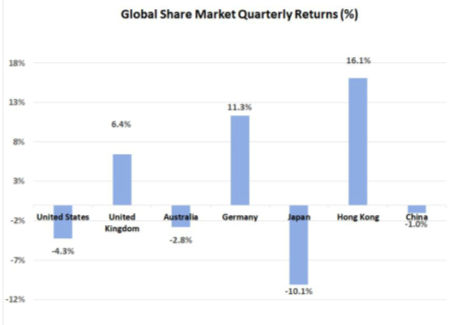March Quarter 2025: US Tariffs trigger share market losses
- Mark Gibson

- Apr 15
- 4 min read
Updated: Aug 29
Share markets were sold down during the March quarter in response to developments around the U.S. tariff program.
U.S. bond yields declined as expectations for U.S. economic growth subsided.
Defensive and interest rate sensitive equities outperformed, with global infrastructure and property producing positive returns.

International Equities

Concerns over the growing U.S. tariff
program, and the negative impact
this may have on economic growth,
continued to weigh heavily on share
markets over the March quarter.
Most of the reduction took place in
late February and early March.
However, after stabilising mid-month,
there was another step down late in
March ahead of the “Liberation Day”
tariff announcements on April 2nd. With much of the concern being centred around the impact of tariffs on the U.S. economy, the U.S. share market led global markets lower with the S&P 500 Index falling 4.3% over the quarter.
Following two years of leading the market higher, there were significant losses across the large U.S. technology sector, with Alphabet (Google), Tesla and Nvidia all recording drawdowns of more than 15% for the quarter.
Defensive stocks on the U.S. market performed materially better than average, with gains recorded in the healthcare, utilities, and consumer staples sectors. In contrast, smaller companies were sold down, as was the consumer discretionary sector, which dropped in value by 16.2% over the quarter.
In contrast to the U.S. market, a number of European markets posted positive returns over the quarter. Hopes that a German government announcement of a new spending program (heavily orientated towards defence) will be the start of a greater willingness by European authorities to use fiscal stimulus, helped support European markets last month.
Additionally, the European share market is generally regarded as being cheaper, more defensive, and more “value” orientated in style than the U.S., all factors which generally provide support in a period of equity market weakness.
Similarly, the Chinese share market was also buoyed by a government announcement indicating a renewed commitment to supporting domestic growth and consumer spending. Overall, the Chinese market was flat for the quarter. This enabled the MSCI Emerging Market Index to finish the quarter in slightly positive territory, with gains recorded in Eastern Europe and South America. Taiwan, however, stood out with an 11.5% decline, which reflected the broader negative sentiment attached to the technology sector last month. The Indian market was also 3.1% lower, despite a strong bounce back late in the quarter.
Global real assets generally held up well. Infrastructure benefited from an ongoing shift to defensive sectors and gained 3.4%. With an annual return of 18.6%, infrastructure is now the top performing asset class on a 12-month basis. Global listed property firmed 0.7% higher for the quarter.
In contrast, Australian listed property declined 5.4%, with the largest constituent and data centre specialist, Goodman Group, leading the sector lower with a decline of 19.7%.
Australian Equities

Australian equities performed closely in line with the global average over the March quarter, with the S&P ASX 200 Index falling
2.8%.
The pattern of price movement across sectors was like that prevailing on the U.S. market, with technology the weakest sector with a 17.5% decline.
Defensive sectors had more support over the quarter, although a negative reaction to CSL’s half year earnings results saw it drag the healthcare sector lower.
Resources finished the quarter in slightly positive territory, which may have reflected more positive sentiment around the outlook for the Chinese economy.
Fixed Interest and Currencies

The trajectory of global cash interest rates continued to be downwards over the quarter.
A 0.25% cut was announced by the European Central Bank in early
March, following the 0.25%
reduction in the Australian cash rate in mid-February. Australia’s cash interest rate now stands at 4.10%.
Despite the expected inflationary consequences of the U.S. tariff program and the lack of prospect of near-term policy easing, U.S. longer term yields declined over the quarter to reflect a weaker economic growth outlook.
The U.S. 10-year Treasury Bond yield was 0.35% lower at 4.23%. Australia’s 10-year government bond was steady, however, yielding 4.38%.
The Australian dollar remained relatively stable over the quarter, despite its historical tendency to decline in periods of weaker equity markets. Against the U.S. dollar, the $A firmed from U.S. 62.2 cents to U.S. 62.8 cents. However, the $A was weaker against both the Euro and Japanese Yen, by 3.0% and 3.6% respectively.
Important Information
The following indexes are used to report asset class performance: ASX S&P 200 Index, MSCI World Index ex Australia net AUD TR, MSCI World ex Australia NR Hdg AUD, FTSE EPRA/NAREIT Developed REITs Index Net TRI AUD Hedged, Bloomberg AusBond Composite 0 Yr Index, Barclays Global Aggregate ($A Hedged), Bloomberg AusBond Bank Bill Index, S&P ASX 300 A- REIT (Sector) TR Index AUD, S&P Global Infrastructure NR Index (AUD Hedged), CSI China Securities 300 TR in CN, Deutsche Borse DAX 30 Performance TR in EU. Hang Seng TR in HKD, MSCI United Kingdom TR in GBP, Nikkei 225 in JPY, S&P 500 TR in USD.
General Advice Disclaimer
This document has been prepared by Sage Advisers, trading as “Brad Matthews Investment Strategies” (BMIS). Sage Advisers is a Corporate Authorised Representative of Sage Advisers Pty Ltd (AFSL 238039). The document is intended for the use of financial adviser clients of BMIS and their staff only. Any advice provided is of a general nature and does not take into account personal circumstances. Any decision to invest in products mentioned in this document should only be made after reviewing the relevant Product Disclosure Statements. Past performance is not a reliable indicator of future performance.




Comments